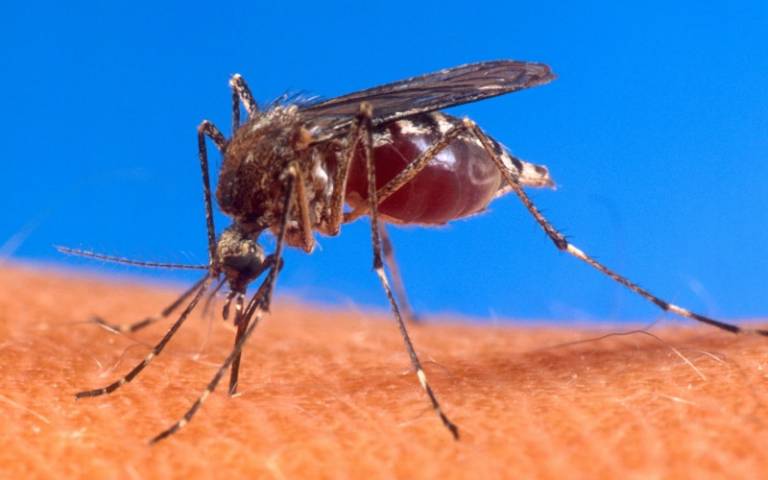Mosquito genome opens new avenues for reducing disease
16 November 2018
An international research team involving UCL scientists has mapped the genome of the mosquito that carries the Zika, dengue fever and yellow fever viruses.

For the past decade, researchers attempting to study the mosquito’s DNA had only fragments to work with, that didn’t come together to form a cohesive whole. The latest study, led by scientists at The Rockefeller University, has produced a new blueprint of the Aedes aegyptigenome that vastly improves upon its predecessor.
The study, published in Nature, describes important applications of this new resource, including multiple strategies for reducing mosquito-borne illnesses.
“This new high-quality genome assembly is accelerating basic mosquito science, as we’re learning more about how mosquitoes develop resistance to current insecticides, and finding new targets for better insecticides,” said Professor David Sattelle (UCL Medicine), one of the co-authors of the paper, alongside Dr Steven Buckingham and Dr Frederick Partridge (all UCL Medicine).
Like several other mosquito species, Ae. aegypti carries harmful pathogens, and transmits these diseases to hundreds of millions of people annually. Many researchers believe that the best way to curb infection is to better understand the infectors.
To this end, in 2007 scientists began sequencing the mosquito’s large and repetitive genome. Though results of this effort enabled over a decade of mosquito genetic research, the techniques of the time were limited and the genome had significant shortcomings.
Following the 2016 Zika outbreak, scientists’ frustration escalated as the disease became a public health crisis, prompting Professor Leslie Vosshall (The Rockefeller University) to set up an international collaboration, which has now yielded a comprehensive, robust catalogue of Ae. aegypti DNA.
Using this high-quality genome blueprint, the researchers have characterised previously unidentified genes. They found, for example, multiple genes coding for dozens of new receptors that detect odours and help guide mosquitoes toward important locations, such as a site to lay eggs or a person’s exposed skin. With these new genetic details, researchers may now be able to develop novel insect repellants that interfere with mosquitoes’ ability to find and bite people.
The researchers also noticed that some mosquitoes had multiple copies of genes coding for an enzyme that neutralises the toxic effects of insecticides, suggesting that Ae. aegypti are evolving to protect themselves from man-made toxins. This discovery could help researchers create chemicals that eliminate mosquitoes resistant to existing insecticides.
The UCL researchers, alongside collaborators at the Liverpool School of Tropical Medicine and Oxford Brookes University, led on characterising a family of molecules involved in rapid signaling between cells, as targets for new larvicides (insecticides that target insect larvae). They have also developed an automated screening platform to search for novel control chemicals or to find chemicals already in use that could be repurposed.
The UCL scientists are continuing to investigate if new chemicals derived from fungi could target signaling receptors that aren’t found in humans, in the hope they could be safe to use for mosquito control.
Another strategy of mosquito control could be to modify genes to make the insect less threatening to humans. To this end, the researchers were able to pinpoint genes responsible for determining the sex of a mosquito, a finding that could be used to engineer male-only populations – which would entail a reduction in virus transmission as only female mosquitoes bite people.
Yet some Ae. aegypti cannot be infected by the dengue virus, and therefore cannot transmit it to humans. The team was able to determine the location of genes that control susceptibility to the virus, which could help scientists alter the DNA to render the species incapable of spreading the disease.
“To effectively edit the genome of the mosquito, you need to know more than just the sequence of the genes involved. You also need to know the sequence of the surrounding DNA regions, so that you know where to insert the desired genes. And that’s why it’s so important that this new genome is correct and complete,” said Dr Ben Matthews (The Rockefeller University), the study’s first author who works in Professor Vosshall’s lab.
As the group released their genome online a year prior to formally publishing their study, multiple international research teams are now using this tool to perform new experiments. The research has the potential to assist not only scientists studying mosquitoes, but also those attempting to improve the quality and availability of genomic resources for diverse species.
“In addition to getting the best genome for Ae. aegypti, we've also made a roadmap for how to assemble other tricky genomes. This lays out a strategy for taking any organism and turning it into a genetically tractable animal,” added Dr Matthews.
Links
- Research paper in Nature
- Professor David Sattelle's academic profile
- Dr Steven Buckingham's academic profile
- Dr Frederick Partridge's academic profile
- UCL Medicine
Image
- Aedes aegypti. Credit: Dr Gareth Lycett, Liverpool School of Tropical Medicine
Source
Media contact
Chris Lane
Tel: +44 (0)20 7679 9222
Email: chris.lane [at] ucl.ac.uk
 Close
Close

